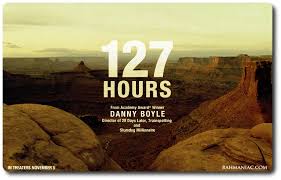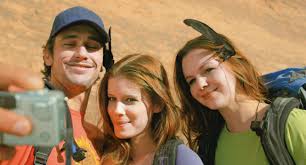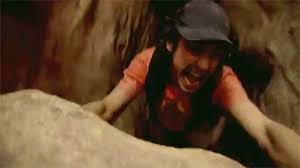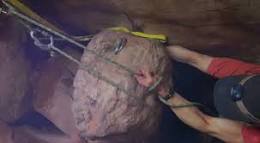By now, you've probably all heard the story of Aron Ralston, the man who went canyoneering in Utah one fateful morning in April 2003 only to get his arm stuck between a boulder and the canyon wall, hidden deep in the earth. He was trapped there for five days before amputating the arm with a dull knife and finding rescue. Its an intense, unbelievable story, the kind of story that would be uplifting and inspirational in movie form.




But make no mistake, 127 Hours doesn't take the saccharine route. Instead, this is one intense, gripping, edge-of-your-seat film, the kind that doesn't let go for a second. The film is listed as a thriller, but it actually has more in common with survival horror. After a brief prologue in which Aron (James Franco) encounters two fellow hikers (Amber Tamblyn and Kate Mara) and shows off his adventurous side, the accident happens, and from then on, in terms of physical setting at least, the film stays in one place. The audience is pushed to feel what Aron is experiencing, from the scant amount of food he has to his limited water. At first, we feel his desperation, which comes in waves as his situation becomes more and more dire. I say waves because, perhaps scariest of all, there are moments where he seems to accept death as the only option, and seems to decide to just wait it out; at best, he only has a few days. And with each new predicament, the audience gets the same heart-pumping, pulse-pounding intensity that Aron is going through on screen. If you see this film, I highly recommend trying to see it with as few other people as possible; I think the less people you have in the room with you the more intense and ultimately rewarding experience you'll have.
I mentioned above that the film is mostly stuck in one place physically, just like its protagonist. That's part of what made the choice of Danny Boyle as director so odd: why would one of cinema's most energetic, forward-momentum-minded directors (he of Slumdog Millionaire, 28 Days Later, and Trainspotting) take on a project where the main characters can't move for most of the film? But Boyle turns out to be a fantastic choice, as he prevents the film from being sedentary by diving into Aron's mind, exploring his inner workings as he reflects on the life that lead him to this point and how he's coping with his situation. Boyle makes excellent use of the always-risky split-screen, showing images that range from the vast isolation of the Utah landscape to the menacing, mocking dripping of water from a faucet. Yes, its all very stylistic filmmaking, and it certainly won't convert any of Boyle's detractors, but his style is just one of the things bringing this film to vivid life.
The other would be James Franco, fearlessly and magnificently taking the lead role to new heights in what is, to me, the best performance I've seen so far this year. The film is essentially a one-man show, since Franco's only screen partner most of the time is the boulder that's trapped his arm. This is risky, given that the lead will have to be phenomenal in order to hold the screen and keep the audience involved. And Franco is phenomenal and more, commanding attention to him and proving his formidable acting talents. Without anyone to play off of, Franco expresses so much in just the look in his eyes and the corners of his mouth, the wide smiles of the beginning fading to despair and fear punctuated by panic. His portrayal of Aron's transformation as time drags on is spectacular: at first, he panics, but then he proves to be very resourceful, using all of his available materials to try to move the boulder, but as time drags on, his will to live is eroding, and he finds himself becoming more and more dispirited. In one particularly powerful scene, Aron turns on his video camera and does a morning-talk-show with himself, at first darkly laughing off his situation before angrily blaming himself for being there and resigning that he will die. Its an incredible sequence, and Franco completely sells the sorrow, self-awareness, and madness of it. Given how much the multi-hyphenate has done this year, there seems to be no end to the wonders that Franco can do. He's just started showing us the depths of his incredible talents.
Yes, there is a graphic amputation scene. No, nobody at my screening passed out. But it should be noted that its not graphic in the sense of just blood and gore; this isn't Saw or Hostel. What makes this scene so difficult to watch is the emotion that Franco puts into it, the agonizing pain that fires through his face and, therefore, through us as well. That said, it is quite bloody and intense, so the faint-hearted should probably avoid this film. But for those of you willing to take the plunge into the barest, most basic of human survival instincts, see this as soon as possible. Its a rewarding experience.
Comments